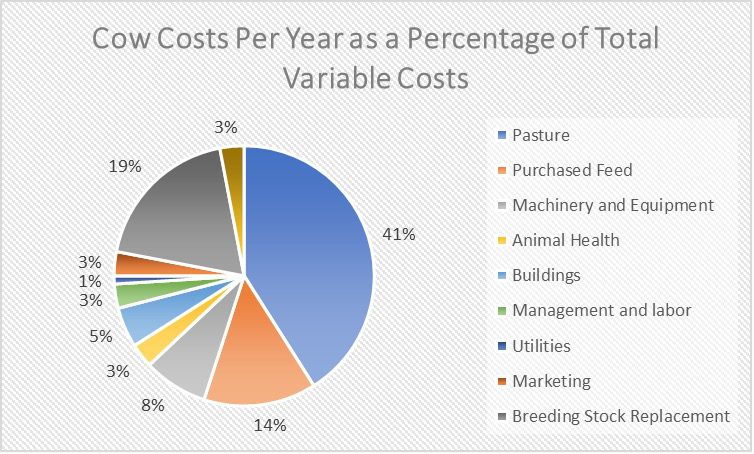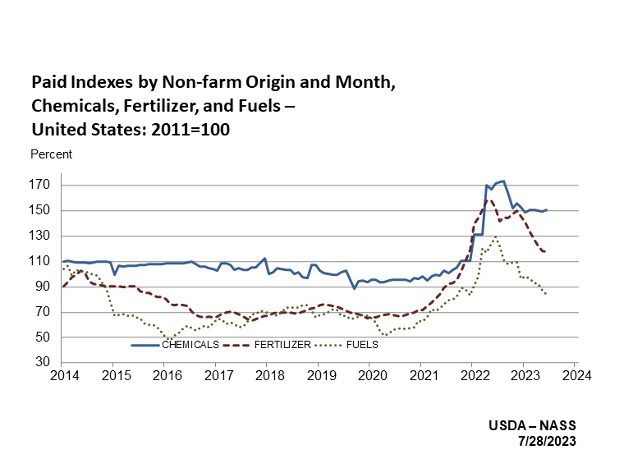Source: Alabama Cooperative Extension System, Ken Kelley and Walter J. Prevatt
Profitable cow-calf producers consistently seek ways to maximize income and minimize production costs. This requires producers to carefully consider both income and expenses.

Figure 1. Year-to-year variations in the cost of farm inputs.
As figure 1 illustrates, there are year-to-year variations in the cost of farm inputs such as fertilizer, diesel, and feed. However, as figure 1 also illustrates, the general trend for input prices over time is to increase. So, producers should anticipate higher input prices and plan to mitigate those cost increases as much as possible. This does not mean merely cutting back on expenses but investing in inputs that have a positive return. See enterprise budgets for livestock on the Alabama Extension website at www.aces.edu.
Figure 2 further shows where the costs come from for a typical Alabama cow-calf operation. Most producers will find that pasture and feed costs make up most of their yearly expenses. These prices and percentages change from year to year based on input prices, but as shown in figure 3, they have certainly increased in general over the last 3 years.
Where to Start?
Since each producer and situation differ, the first step is gathering information about the operation. For many producers, this may mean implementing a better record keeping (and record gathering) system so they can truly know the expenses of their operation. Then, expenses can be categorized, allowing for evaluation of the expenses. Remember, some expenses are inherent to cattle production. These expenses cannot and should not be eliminated, but a progressive and efficient manager will constantly be seeking ways to minimize these expenses while maximizing profit.

Figure 2. Source of costs for a typical Alabama cow-calf operation.
How to Lower Purchased-Feed Costs
- Develop a purchasing plan for feed—amount to spend, type of feedstuffs, quantity, quality, etc.
- Minimize the need for using purchased feeds.
- Have feed analyzed for nutrient composition.
- Use purchased feeds based on nutritional needs of cowherd and replacements—lactating, gestating, dry, growing, etc.
- Buy purchased feeds in volume and at seasonal low prices when storage is practical.
- Identify alternative feeds and byproduct feed stuffs.
- Compare alternative feed prices and nutrient costs.
- Develop feed rations based on feed and forage analyses.
- Minimize feed losses during storage and feeding.
- Compare alternative feed, storage, and feeding costs.
- Buy feedstuffs by weight and quality instead of bulk measure (bale, roll, trailer load, etc.).
- Consider incorporating cool- and warm-season forages (legumes and grasses) in your grazing plan to reduce dependence on purchased feeds and nitrogen fertilizer.
- Consider whether forage species or forage variety selection can lengthen the grazing season and thus lower purchased feed needs.

Figure 3. Increase in pasture and feed costs in the past three years.
How to Lower Raised-Feed Costs
- Plan your anticipated raised-feed needs (best and worst case scenarios).
- Minimize the use of raised feeds when it is economically advantageous to grow forages.
- Compare the costs of raising, harvesting, and storing alternative raised feeds.
- Compare your cost of harvesting raised feed with custom harvesting rates.
- Compare your cost of raised feeds with alternative purchased feeds (buy feed if it is cheaper than self-raising and harvesting feed).
- Consider weather, labor availability, and machinery readiness to minimize harvested feed losses.
- Consider feed storage facilities to minimize feeding losses.
- Consider the use of feed panels or rings to minimize feeding losses.
- Borrow, share, or rent machinery and labor with neighbors.
- Use limit-feeding techniques (rolling out hay, etc.) when practical.
How to Lower Grazing Costs
- Develop a grazing plan to use your inputs, resources, and forages better.
- Soil test to determine fertilizer nutrients or lime needs.
- Evaluate alternative fertilizer formulation prices and spreading costs to reduce the cost of fertilizers and fertilizing.
- Where possible, incorporate legumes into perennial pastures to lower nitrogen fertilizer costs and improve forage quality.
- Split fertilizer applications if doing so will minimize fertilizer losses.
- When prices and availability permit, use noncommercial fertilizer sources (animal wastes, sludge, light industry and mining materials, etc.).
- Consider leasing additional land when lease rates are cheaper than fertilization costs (compare dollars per assets under management [AUM] or dollars per unit of dry matter forage production).
- Practice weed control (chemical or mechanical) only when it is economically to your advantage.
- Where practical, improve forage use with improved grazing methods (creep, limit, rotational, intensive, etc.).
- Adjust fertilizing and stocking rate levels based on calf and fertilizer prices (for example, higher fertilizer costs imply lower fertilizer levels, which result in lower stocking rates and fewer cows per acre).
- Consider stockpiling certain forages for use as standing hay if possible in your area.
- Consider drilling or overseeding cool-season forages (grasses and legumes) to lengthen the grazing season and reduce your purchased or raised-feed needs.
- Provide animals with the highest nutritional requirements access to the highest quality pasture.
How to Lower Cattle Costs
- Develop a cattle management plan—production, reproduction, nutrition, herd health, feeds, forages, marketing, etc.
- Adopt a controlled breeding season to improve or reduce management and labor costs.
- Consider adjusting cow-herd inventory and stocking rate due to lower beef prices or higher input costs. Lower calf prices imply lower fertilizer levels, resulting in lower stocking rates and fewer cows per acre.
- Review cow-herd records and cull open, defective, low-producing cows, especially older cows.
- Keep only the essential number of replacement animals to achieve the desired herd inventory. Developing replacement animals is expensive.
- Consider the economics of buying versus raising replacement animals.
- Try to keep cows productive over a longer time period.
- Perform preventive herd health practices to reduce emergency costs and losses.
- Compare prices of herd-health animal products.
- Reduce cow frame size over time if needed to lower total feed requirements.
- Sort cows into groups based on nutritional needs to improve or reduce management and feed costs.
- Use caution when selecting inputs to increase weaning percent or weights during years of low beef-market prices. The expense of some inputs will exceed the income their use will generate.
Summary
Cow-calf producers must continually monitor fluctuating input prices and make management decisions to sustain their operations. These decisions involve knowing what your farm is spending and receiving and what national and international markets are doing. That means that producers must be timely in their record keeping and management. Without proper records, it is challenging to know what your expenses are. Current and projected production costs and revenues provide producers with the knowledge and timeliness to adjust their operations before adverse market price conditions occur. Producers who want to improve cow-calf profitability are producers who manage their production costs at all times.









